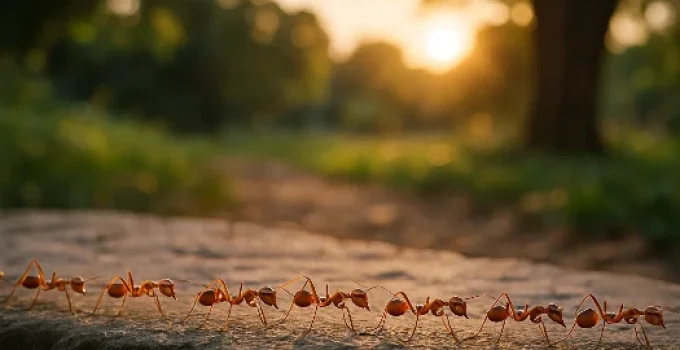Why Do Ants March in a Line?
Answer at a Glance: Ants march in a line because they follow scent trails made by other ants. When a worker ant finds food, it releases a special chemical signal called a pheromone on the ground. Other ants smell this trail and follow it in a straight line to the food. It’s one of the ways ants communicate and work as a team.
🔎 Dive Deeper
- What Are Pheromones and How Do Ants Use Them?
- How Do Ants Know Where to Go?
- Why Are Ants So Organized?
- What Happens if the Trail Breaks?
- Do All Ants Follow Trails?
- 🎯 Final Thoughts
- 📚 References
What Are Pheromones and How Do Ants Use Them?
Ants can’t talk, but they communicate through chemicals called pheromones. These signals are released from special glands on their bodies.
- A worker ant that finds food lays down a pheromone trail on its way back to the nest.
- Other ants smell the trail with their antennae and follow it exactly.
- As more ants follow the path, they reinforce the trail with even more pheromones.
🧪 Fun Fact: Some species of ants can create up to 10 different pheromone types, each with a unique message—like “danger,” “follow me,” or “food ahead.” [1]
How Do Ants Know Where to Go?
Ants rely on scent and memory to know where to go. When they walk, they:
- Smell the ground using their antennae.
- Choose the path with the strongest scent.
- If the scent fades, they turn around or explore a new direction.
Some ants also use the position of the sun, their internal body clocks, and even magnetic fields to help navigate long distances. But for most ant species, pheromone trails are the main guide.
Why Are Ants So Organized?
Ants seem incredibly organized because they follow simple rules that result in complex teamwork. This is called swarm intelligence.
Here’s how it works:
- Each ant follows the trail without needing a boss or leader.
- The trail gets stronger when more ants walk over it.
- If the food runs out, the trail fades, and the ants stop coming.
This system lets ants find the fastest and most efficient route between their nest and a food source.
📊 Interesting Stat: A single ant colony can work together to build trails up to 100 feet long, involving thousands of ants all following the same path. [2]
What Happens if the Trail Breaks?
If something interrupts the trail—like water, wind, or a finger swipe—ants might:
- Wander around in circles looking for the scent.
- Try to reconnect with the broken trail by searching nearby.
- Eventually, a new worker may find a way and rebuild the path with fresh pheromones.
Sometimes, if the trail forms a loop and ants can’t find the end, they get stuck following each other in a circle. This is called a death spiral, and it can lead to ants walking in circles until they die from exhaustion.
😨 This is rare but has been observed in army ants. Scientists call it a “circular milling pattern.” [3]
Do All Ants Follow Trails?
Not all ant species use scent trails in the same way. Some use visual cues, touch, or even vibration to communicate. But for most common ants like:
- Argentine ants
- Black garden ants
- Red imported fire ants
…pheromone trails are the main way they organize group foraging.
Some species also build living bridges or use leaf boats to cross gaps while keeping the trail connected!
🎯 Final Thoughts
So, why do ants march in a line? Ants marching in a line may look simple, but it’s actually a brilliant example of teamwork and communication. By using pheromones, ants can create highways that guide thousands of workers straight to food. This behavior helps colonies survive, thrive, and stay organized—without needing a single leader to give orders.
Next time you see a line of ants, remember: you’re watching a chemical conversation in action!
📚 References
- Hölldobler, B., & Wilson, E. O. (1990). The Ants. Harvard University Press.
- Gordon, D. M. (2010). “Ant Encounters: Interaction Networks and Colony Behavior.” Princeton University Press.
- Schneirla, T. C. (1944). “A unique case of circular milling in ants.” Journal of Comparative Psychology, https://doi.org/10.1037/h0060547
- National Geographic. “How Ants Use Scent Trails to Stay Organized.” https://www.nationalgeographic.com
📌Learn More About Ants
- How Do Ants Reproduce?🐜A Deep Dive Into Colony Growth
- Do Ants Have Blood?🐜 The Surprising Truth about Insect Circulation
- Can Ants Smell? 🐜 Exploring the Chemical World of Ant Communication
- Can Ants Swim? 🐜 Exploring the Aquatic Abilities of Earth’s Hardest Workers
- Do Ants Eat Termites? 🐜 The Many Termite Predators
- Do Ants Have Brains? 🐜 Inside the Mind of Nature’s Minature Engineers
- Do Ants Have Muscles? 🐜 Explore What These Muscular Powerhouses Can Do
- Do Ants Sleep? 🐜 Ants Are Supersonic Power Nappers!
- How Long Do Ants Live? 🐜 A Look Into the Lifespan of the Colony
- What Do Ants Eat? 🐜 Inside the Pantry of an Ant Colony
- Are Ants Blind? 🐜How These Tiny Insects See the World
